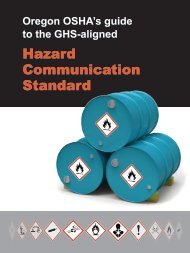Technical Manual - Section 3 (Safety Hazards)
Technical Manual - Section 3 (Safety Hazards)
Technical Manual - Section 3 (Safety Hazards)
Create successful ePaper yourself
Turn your PDF publications into a flip-book with our unique Google optimized e-Paper software.
THERMOFOR CATALYTIC CRACKING<br />
In a typical thermofor catalytic cracking unit, the preheated<br />
feedstock flows by gravity through the catalytic reactor bed.<br />
The vapors are separated from the catalyst and sent to a<br />
fractionating tower. The spent catalyst is regenerated, cooled,<br />
and recycled. The flue gas from regeneration is sent to a<br />
carbon-monoxide boiler for heat recovery.<br />
HEALTH AND SAFETY CONSIDERATIONS<br />
Fire Prevention and Protection<br />
Liquid hydrocarbons in the catalyst or entering the heated<br />
combustion air stream should be controlled to avoid<br />
exothermic reactions. Because of the presence of heaters in<br />
catalytic cracking units, the possibility exists for fire due to<br />
a leak or vapor release. Fire protection including concrete or<br />
other insulation on columns and supports, or fixed water<br />
spray or fog systems where insulation is not feasible and in<br />
areas where firewater hose streams cannot reach, should be<br />
considered. In some processes, caution must be taken to<br />
assure prevent explosive concentrations of catalyst dust<br />
during recharge or disposal. When unloading any coked<br />
catalyst, the possibility exists for iron sulfide fires. Iron<br />
sulfide will ignite spontaneously when exposed to air and<br />
therefore mus be wetted with water to prevent it from igniting<br />
vapors. Coked catalyst may be either cooled below 120º F<br />
before they are dumped from the reactor, or dumped into<br />
containers that have been purged and inerted with nitrogen<br />
and then cooled before further handling.<br />
<strong>Safety</strong><br />
Regular sampling and testing of the feedstock, product, and<br />
recycle streams should be performed to assure that the<br />
cracking process is working as intended and that no<br />
contaminants have entered the process stream. Corrosives or<br />
deposits in the feedstock can foul gas compressors.<br />
Inspections of critical equipment including pumps,<br />
compressors, furnaces, and heat exchangers should be<br />
conducted as needed. When processing sour crude, corrosion<br />
may be expected where temperatures are<br />
below 900 o F. Corrosion takes place where both liquid and<br />
vapor phases exist, and at areas subject to local cooling such<br />
as nozzles and platform supports.<br />
When processing high-nitrogen feedstocks, exposure to<br />
ammonia and cyanide may occur, subjecting carbon steel<br />
equipment in the FCC overhead system to corrosion,<br />
cracking, or hydrogen blistering. These effects may be<br />
minimized by water wash or corrosion inhibitors. Water wash<br />
may also be used to protect overhead condensers in the main<br />
column subjected to fouling from ammonium hydrosulfide.<br />
Inspections should include checking for leaks due to erosion<br />
or other malfunctions such as catalyst buildup on the<br />
expanders, coking in the overhead feeder lines from feedstock<br />
residues, and other unusual operating conditions.<br />
Health<br />
Because the catalytic cracker is a closed system, there is<br />
normally little opportunity for exposure to hazardous<br />
substances during normal operations. The possibility exists of<br />
exposure to extremely hot (700º F) hydrocarbon liquids or<br />
vapors during process sampling or if a leak or release occurs.<br />
In addition, exposure to hydrogen sulfide and/or carbon<br />
monoxide gas may occur during a release of product or vapor.<br />
Catalyst regeneration involves steam stripping and decoking,<br />
and produces fluid waste streams that may contain varying<br />
amounts of hydrocarbon, phenol, ammonia, hydrogen sulfide,<br />
mercaptan, and other materials depending upon the<br />
feedstocks, crudes, and processes. Inadvertent formation of<br />
nickel carbonyl may occur in cracking processes using nickel<br />
catalysts, with resultant potential for hazardous exposures.<br />
Safe work practices and/or the use of appropriate personal<br />
protective equipment may be needed for exposures to<br />
chemicals and other hazards such as noise and heat; during<br />
process sampling, inspection, maintenance and turnaround<br />
activities; and when handling spent catalyst, recharging<br />
catalyst, or if leaks or releases occur.<br />
III:2-28
















